Data-Driven Classification and Logging Prediction of Mudrock Lithofacies Using Machine Learning: Shale Oil Reservoirs in the Eocene Shahejie Formation, Bonan Sag, Bohai Bay Basin, Eastern China
Abstract
:1. Introduction
2. Geological Setting
3. Samples and Methods
3.1. Data
3.1.1. Core Samples
3.1.2. Thin Sections
3.1.3. X-Ray Diffraction
3.1.4. Microdomain TOC
3.1.5. Logging Data
3.2. Machine-Learning Algorithms
3.2.1. Principal Component Analysis (PCA)
3.2.2. Hierarchical Cluster Analysis (HCA)
3.2.3. Random Forest (RF)
3.2.4. Grid Search (GS)–K-Fold Cross Validation (KCV)–Random Forest (RF)
3.3. The Workflow of Lithofacies Prediction
4. Results
4.1. Quantitative Classification of Lithofacies
4.1.1. Principal Component Extraction
4.1.2. Types of Lithofacies
4.1.3. Petrophysical Characteristics of Different Lithofacies
4.2. Logging Identification for Lithofacies
4.2.1. Logging Parameters Selection
4.2.2. Logging Response and Lithofacies Comparison
- (1)
- The GR values of the lithofacies can be divided into three levels. The LCC lithofacies exhibited the highest values. The GR values of the CLAL lithofacies were similar to the MAL lithofacies. The ILAL and LMS lithofacies had the lowest values.
- (2)
- The SP values of the MAL and CLAL lithofacies were the highest, followed by those of the LCC lithofacies. The SP values of the ILAL and LMS lithofacies are the lowest.
- (3)
- The CNL values of the five lithofacies had little difference, but the values of the CLAL lithofacies were slightly lower than those of the other four lithofacies.
- (4)
- The DEN values were the highest for CLAL lithofacies and lowest for LMS lithofacies. The MAL, LCC, and ILAL lithofacies, in second place, had a similar DEN value.
- (5)
- The AC values of the ILAL and LMS lithofacies were the highest with the development of a laminar structure, followed by the MAL and LCC lithofacies, whereas the CLAL lithofacies were the lowest.
- (6)
- The LLD values of the ILAL lithofacies were the highest because of the high TOC content and poor electrical conductivity of the kerogen, whereas those of the LCC and LMS lithofacies were lower. The MAL and CLAL lithofacies had the lowest LLD values.
4.2.3. GS–KCV–RF for Lithofacies Identification
4.2.4. Verification of Identification Accuracy
5. Discussion
5.1. Performances and Improvements of Machine-Learning Models
5.2. Applications of Machine-Learning Models
6. Conclusions
- Instead of previous manual classification, PCA and HCA automatically classify mudrock lithofacies of the third submember reservoir in the Bonan Sag into five types: MAL, LCC, ILAL, CLAL, and LMS. The lithofacies classification of PCA and HCA, according to the similarity of the samples’ known petrological and petrophysical properties, can streamline decision-making processes and increase efficiency in lithofacies classification.
- The RF model, optimized by GS and KCV, effectively predicts mudrock lithofacies from conventional logging data in non-cored intervals. The values of accuracy, precision, recall, and F1-score is 97.7%, 93.2%, 94.0%, and 93.4%, respectively.
- The horizontal distribution of lithofacies that was predicted by machine-learning models indicated that the favorable areas for petroleum exploration in the Bonan Sag were the Boshen4 Step-Fault Zone and Bonan Deep Sag Zone.
Author Contributions
Funding
Data Availability Statement
Acknowledgments
Conflicts of Interest
References
- Hickey, J.J.; Henk, B. Lithofacies Summary of the Mississippian Barnett Shale, Mitchell 2 T.P. Sims Well, Wise County, Texas. AAPG Bull. 2007, 91, 437–443. [Google Scholar] [CrossRef]
- Ou, C.; Li, C.; Rui, Z.; Ma, Q. Lithofacies Distribution and Gas-Controlling Characteristics of the Wufeng–Longmaxi Black Shales in the Southeastern Region of the Sichuan Basin, China. J. Pet. Sci. Eng. 2018, 165, 269–283. [Google Scholar] [CrossRef]
- Jamil, M.; Siddiqui, N.A.; Usman, M.; Wahid, A.; Umar, M.; Ahmed, N.; Haq, I.U.; El-Ghali, M.A.K.; Imran, Q.S.; Rahman, A.H.A.; et al. Facies Analysis and Distribution of Late Palaeogene Deep-water Massive Sandstones in Submarine-fan Lobes, NW Borneo. Geol. J. 2022, 57, 4489–4507. [Google Scholar] [CrossRef]
- Jamil, M.; Siddiqui, N.A.; Ahmed, N.; Usman, M.; Umar, M.; Rahim, H.U.; Imran, Q.S. Facies Analysis and Sedimentary Architecture of Hybrid Event Beds in Submarine Lobes: Insights from the Crocker Fan, NW Borneo, Malaysia. JMSE 2021, 9, 1133. [Google Scholar] [CrossRef]
- Sayed, M.A.; Al-Muntasheri, G.A.; Liang, F. Development of Shale Reservoirs: Knowledge Gained from Developments in North America. J. Pet. Sci. Eng. 2017, 157, 164–186. [Google Scholar] [CrossRef]
- Zhu, H.; Kong, X.; Long, H.; Huai, Y. Duvernay Shale Lithofacies Distribution Analysis in the West Canadian Sedimentary Basin. IOP Conf. Ser. Earth Environ. Sci. 2018, 121, 052007. [Google Scholar] [CrossRef]
- Abouelresh, M.O.; Slatt, R.M. Lithofacies and Sequence Stratigraphy of the Barnett Shale in East-Central Fort Worth Basin, Texas. AAPG Bull. 2012, 96, 1–22. [Google Scholar] [CrossRef]
- Bai, C.; Yu, B.; Han, S.; Shen, Z. Characterization of Lithofacies in Shale Oil Reservoirs of a Lacustrine Basin in Eastern China: Implications for Oil Accumulation. J. Pet. Sci. Eng. 2020, 195, 107907. [Google Scholar] [CrossRef]
- Chen, X.; Wang, C.; Kuhnt, W.; Holbourn, A.; Huang, Y.; Ma, C. Lithofacies, Microfacies and Depositional Environments of Upper Cretaceous Oceanic Red Beds (Chuangde Formation) in Southern Tibet. Sediment. Geol. 2011, 235, 100–110. [Google Scholar] [CrossRef]
- Dong, T.; Harris, N.B.; Ayranci, K.; Twemlow, C.E.; Nassichuk, B.R. Porosity Characteristics of the Devonian Horn River Shale, Canada: Insights from Lithofacies Classification and Shale Composition. Int. J. Coal Geol. 2015, 141–142, 74–90. [Google Scholar] [CrossRef]
- Loucks, R.G.; Ruppel, S.C. Mississippian Barnett Shale: Lithofacies and Depositional Setting of a Deep-Water Shale-Gas Succession in the Fort Worth Basin, Texas. AAPG Bull. 2007, 91, 579–601. [Google Scholar] [CrossRef]
- Wang, G.; Cheng, G.; Carr, T.R. The Application of Improved NeuroEvolution of Augmenting Topologies Neural Network in Marcellus Shale Lithofacies Prediction. Comput. Geosci. 2013, 54, 50–65. [Google Scholar] [CrossRef]
- Wang, P.; Jiang, Z.; Yin, L.; Chen, L.; Li, Z.; Zhang, C.; Li, T.; Huang, P. Lithofacies Classification and Its Effect on Pore Structure of the Cambrian Marine Shale in the Upper Yangtze Platform, South China: Evidence from FE-SEM and Gas Adsorption Analysis. J. Pet. Sci. Eng. 2017, 156, 307–321. [Google Scholar] [CrossRef]
- Xue, C.; Wu, J.; Qiu, L.; Zhong, J.; Zhang, S.; Zhang, B.; Wu, X.; Hao, B. Lithofacies Classification and Its Controls on the Pore Structure Distribution in Permian Transitional Shale in the Northeastern Ordos Basin, China. J. Pet. Sci. Eng. 2020, 195, 107657. [Google Scholar] [CrossRef]
- Zhao, C.; Jiang, Y.; Wang, L. Data-Driven Diagenetic Facies Classification and Well-Logging Identification Based on Machine Learning Methods: A Case Study on Xujiahe Tight Sandstone in Sichuan Basin. J. Pet. Sci. Eng. 2022, 217, 110798. [Google Scholar] [CrossRef]
- Kadkhodaie, A.; Rezaee, R. Intelligent Sequence Stratigraphy through a Wavelet-Based Decomposition of Well Log Data. J. Nat. Gas Sci. Eng. 2017, 40, 38–50. [Google Scholar] [CrossRef]
- Li, Z.; Zhang, L.; Yuan, W.; Chen, X.; Zhang, L.; Li, M. Logging Identification for Diagenetic Facies of Tight Sandstone Reservoirs: A Case Study in the Lower Jurassic Ahe Formation, Kuqa Depression of Tarim Basin. Mar. Pet. Geol. 2022, 139, 105601. [Google Scholar] [CrossRef]
- Sun, Y.; Chen, J.; Yan, P.; Zhong, J.; Sun, Y.; Jin, X. Lithology Identification of Uranium-Bearing Sand Bodies Using Logging Data Based on a BP Neural Network. Minerals 2022, 12, 546. [Google Scholar] [CrossRef]
- Wei, Z.; Hu, H.; Zhou, H.; Lau, A. Characterizing Rock Facies Using Machine Learning Algorithm Based on a Convolutional Neural Network and Data Padding Strategy. Pure Appl. Geophys. 2019, 176, 3593–3605. [Google Scholar] [CrossRef]
- Antariksa, G.; Muammar, R.; Lee, J. Performance Evaluation of Machine Learning-Based Classification with Rock-Physics Analysis of Geological Lithofacies in Tarakan Basin, Indonesia. J. Pet. Sci. Eng. 2022, 208, 109250. [Google Scholar] [CrossRef]
- Dong, S.-Q.; Zhong, Z.-H.; Cui, X.-H.; Zeng, L.-B.; Yang, X.; Liu, J.-J.; Sun, Y.-M.; Hao, J.-R. A Deep Kernel Method for Lithofacies Identification Using Conventional Well Logs. Pet. Sci. 2023, 20, 1411–1428. [Google Scholar] [CrossRef]
- He, J.; Ding, W.; Jiang, Z.; Li, A.; Wang, R.; Sun, Y. Logging Identification and Characteristic Analysis of the Lacustrine Organic-Rich Shale Lithofacies: A Case Study from the Es 3 L Shale in the Jiyang Depression, Bohai Bay Basin, Eastern China. J. Pet. Sci. Eng. 2016, 145, 238–255. [Google Scholar] [CrossRef]
- Dubois, M.K.; Bohling, G.C.; Chakrabarti, S. Comparison of Four Approaches to a Rock Facies Classification Problem. Comput. Geosci. 2007, 33, 599–617. [Google Scholar] [CrossRef]
- Zheng, W.; Tian, F.; Di, Q.; Xin, W.; Cheng, F.; Shan, X. Electrofacies Classification of Deeply Buried Carbonate Strata Using Machine Learning Methods: A Case Study on Ordovician Paleokarst Reservoirs in Tarim Basin. Mar. Pet. Geol. 2021, 123, 104720. [Google Scholar] [CrossRef]
- Corina, A.N.; Hovda, S. Automatic Lithology Prediction from Well Logging Using Kernel Density Estimation. J. Pet. Sci. Eng. 2018, 170, 664–674. [Google Scholar] [CrossRef]
- Moja, S.S.; Asfaw, Z.G.; Omre, H. Bayesian Inversion in Hidden Markov Models with Varying Marginal Proportions. Math. Geosci. 2019, 51, 463–484. [Google Scholar] [CrossRef]
- Bressan, T.S.; Kehl de Souza, M.; Girelli, T.J.; Junior, F.C. Evaluation of Machine Learning Methods for Lithology Classification Using Geophysical Data. Comput. Geosci. 2020, 139, 104475. [Google Scholar] [CrossRef]
- Xie, Y.; Zhu, C.; Zhou, W.; Li, Z.; Liu, X.; Tu, M. Evaluation of Machine Learning Methods for Formation Lithology Identification: A Comparison of Tuning Processes and Model Performances. J. Pet. Sci. Eng. 2018, 160, 182–193. [Google Scholar] [CrossRef]
- Hall, B. Facies Classification Using Machine Learning. Lead. Edge 2016, 35, 906–909. [Google Scholar] [CrossRef]
- Liu, B.; Zhao, X.; Fu, X.; Yuan, B.; Bai, L.; Zhang, Y.; Ostadhassan, M. Petrophysical Characteristics and Log Identification of Lacustrine Shale Lithofacies: A Case Study of the First Member of Qingshankou Formation in the Songliao Basin, Northeast China. Interpretation 2020, 8, SL45–SL57. [Google Scholar] [CrossRef]
- Wang, G.; Carr, T.R.; Ju, Y.; Li, C. Identifying Organic-Rich Marcellus Shale Lithofacies by Support Vector Machine Classifier in the Appalachian Basin. Comput. Geosci. 2014, 64, 52–60. [Google Scholar] [CrossRef]
- Al-Mudhafar, W.J. Integrating Well Log Interpretations for Lithofacies Classification and Permeability Modeling through Advanced Machine Learning Algorithms. J. Pet. Explor Prod Technol 2017, 7, 1023–1033. [Google Scholar] [CrossRef]
- Bhatt, A.; Helle, H.B. Determination of Facies from Well Logs Using Modular Neural Networks. Pet. Geosci. 2002, 8, 217–228. [Google Scholar] [CrossRef]
- He, J.; La Croix, A.D.; Wang, J.; Ding, W.; Underschultz, J.R. Using Neural Networks and the Markov Chain Approach for Facies Analysis and Prediction from Well Logs in the Precipice Sandstone and Evergreen Formation, Surat Basin, Australia. Mar. Pet. Geol. 2019, 101, 410–427. [Google Scholar] [CrossRef]
- Dev, V.A.; Eden, M.R. Formation Lithology Classification Using Scalable Gradient Boosted Decision Trees. Comput. Chem. Eng. 2019, 128, 392–404. [Google Scholar] [CrossRef]
- Nguyen, H.; Savary-Sismondini, B.; Patacz, V.; Jenssen, A.; Kifle, R.; Bertrand, A. Application of Random Forest Algorithm to Predict Lithofacies from Well and Seismic Data in Balder Field, Norwegian North Sea. AAPG Bull. 2022, 106, 2239–2257. [Google Scholar] [CrossRef]
- Tewari, S.; Dwivedi, U.D. Ensemble-Based Big Data Analytics of Lithofacies for Automatic Development of Petroleum Reservoirs. Comput. Ind. Eng. 2019, 128, 937–947. [Google Scholar] [CrossRef]
- Valentín, M.B.; Bom, C.R.; Coelho, J.M.; Correia, M.D.; de Albuquerque, M.P.; de Albuquerque, M.P.; Faria, E.L. A Deep Residual Convolutional Neural Network for Automatic Lithological Facies Identification in Brazilian Pre-Salt Oilfield Wellbore Image Logs. J. Pet. Sci. Eng. 2019, 179, 474–503. [Google Scholar] [CrossRef]
- Bhattacharya, S.; Carr, T.R.; Pal, M. Comparison of Supervised and Unsupervised Approaches for Mudstone Lithofacies Classification: Case Studies from the Bakken and Mahantango-Marcellus Shale, USA. J. Nat. Gas Sci. Eng. 2016, 33, 1119–1133. [Google Scholar] [CrossRef]
- Wang, G.; Carr, T.R. Marcellus Shale Lithofacies Prediction by Multiclass Neural Network Classification in the Appalachian Basin. Math. Geosci. 2012, 44, 975–1004. [Google Scholar] [CrossRef]
- Liu, H.; Jiang, Y.; Song, G.; Gu, G.; Hao, L.; Feng, Y. Overpressure Characteristics and Effects on Hydrocarbon Distribution in the Bonan Sag, Bohai Bay Basin, China. J. Pet. Sci. Eng. 2017, 149, 811–821. [Google Scholar] [CrossRef]
- Han, S.; Yu, B.; Ruan, Z.; Bai, C.; Shen, Z.; Löhr, S.C. Diagenesis and Fluid Evolution in the Third Member of the Eocene Shahejie Formation, Bonan Sag, Bohai Bay Basin, China. Mar. Pet. Geol. 2021, 128, 105003. [Google Scholar] [CrossRef]
- Wang, M.; Wilkins, R.W.T.; Song, G.; Zhang, L.; Xu, X.; Li, Z.; Chen, G. Geochemical and Geological Characteristics of the Es3L Lacustrine Shale in the Bonan Sag, Bohai Bay Basin, China. Int. J. Coal Geol. 2015, 138, 16–29. [Google Scholar] [CrossRef]
- An, T.; Yu, B.; Wang, Y.; Ruan, Z.; Meng, W.; Feng, Y. Water-Rock Interactions and Origin of Formation Water in the Bohai Bay Basin: A Case Study of the Cenozoic Formation in Bonan Sag. Interpretation 2021, 9, T475–T493. [Google Scholar] [CrossRef]
- Jiu, K.; Ding, W.; Huang, W.; Zhang, Y.; Zhao, S.; Hu, L. Fractures of Lacustrine Shale Reservoirs, the Zhanhua Depression in the Bohai Bay Basin, Eastern China. Mar. Pet. Geol. 2013, 48, 113–123. [Google Scholar] [CrossRef]
- Adler, N.; Golany, B. Including Principal Component Weights to Improve Discrimination in Data Envelopment Analysis. J. Oper. Res. Soc. 2002, 53, 985–991. [Google Scholar] [CrossRef]
- Ma, Y.Z. Lithofacies Clustering Using Principal Component Analysis and Neural Network: Applications to Wireline Logs. Math. Geosci. 2011, 43, 401–419. [Google Scholar] [CrossRef]
- Alzubi, J.; Nayyar, A.; Kumar, A. Machine Learning from Theory to Algorithms: An Overview. J. Phys. Conf. Ser. 2018, 1142, 012012. [Google Scholar] [CrossRef]
- Petroni, A.; Braglia, M. Vendor Selection Using Principal Component Analysis. J. Supply Chain Manag. 2000, 36, 63–69. [Google Scholar] [CrossRef]
- Ghosh, S.; Chatterjee, R.; Shanker, P. Estimation of Ash, Moisture Content and Detection of Coal Lithofacies from Well Logs Using Regression and Artificial Neural Network Modelling. Fuel 2016, 177, 279–287. [Google Scholar] [CrossRef]
- Sfidari, E.; Kadkhodaie-Ilkhchi, A.; Najjari, S. Comparison of Intelligent and Statistical Clustering Approaches to Predicting Total Organic Carbon Using Intelligent Systems. J. Pet. Sci. Eng. 2012, 86–87, 190–205. [Google Scholar] [CrossRef]
- Bubnova, A.; Ors, F.; Rivoirard, J.; Cojan, I.; Romary, T. Automatic Determination of Sedimentary Units from Well Data. Math. Geosci. 2020, 52, 213–231. [Google Scholar] [CrossRef]
- Rahimi, M.; Riahi, M.A. Reservoir Facies Classification Based on Random Forest and Geostatistics Methods in an Offshore Oilfield. J. Appl. Geophys. 2022, 201, 104640. [Google Scholar] [CrossRef]
- Wang, Z.; Cai, Y.; Liu, D.; Qiu, F.; Sun, F.; Zhou, Y. Intelligent Classification of Coal Structure Using Multinomial Logistic Regression, Random Forest and Fully Connected Neural Network with Multisource Geophysical Logging Data. Int. J. Coal Geol. 2023, 268, 104208. [Google Scholar] [CrossRef]
- Jiang, F.; Huo, L.; Chen, D.; Cao, L.; Zhao, R.; Li, Y.; Guo, T. The Controlling Factors and Prediction Model of Pore Structure in Global Shale Sediments Based on Random Forest Machine Learning. Earth-Sci. Rev. 2023, 241, 104442. [Google Scholar] [CrossRef]
- Mahardika T, N.Q.; Fuadah, Y.N.; Jeong, D.U.; Lim, K.M. PPG Signals-Based Blood-Pressure Estimation Using Grid Search in Hyperparameter Optimization of CNN–LSTM. Diagnostics 2023, 13, 2566. [Google Scholar] [CrossRef]
- Yan, T.; Shen, S.-L.; Zhou, A.; Chen, X. Prediction of Geological Characteristics from Shield Operational Parameters by Integrating Grid Search and K-Fold Cross Validation into Stacking Classification Algorithm. J. Rock Mech. Geotech. Eng. 2022, 14, 1292–1303. [Google Scholar] [CrossRef]
- Williams, T.S.; Bhattacharya, S.; Song, L.; Agrawal, V.; Sharma, S. Petrophysical Analysis and Mudstone Lithofacies Classification of the HRZ Shale, North Slope, Alaska. J. Pet. Sci. Eng. 2022, 208, 109454. [Google Scholar] [CrossRef]
- Yan, J.-P.; He, X.; Hu, Q.-H.; Liang, Q.; Tang, H.-M.; Feng, C.-Z.; Geng, B. Lower Es3 in Zhanhua Sag, Jiyang Depression: A Case Study for Lithofacies Classification in Lacustrine Mud Shale. Appl. Geophys. 2018, 15, 151–164. [Google Scholar] [CrossRef]
- Singh, M.; Garg, V.K. A Comprehensive Physico-Chemical Quality and Heavy Metal Health Risk Assessment Study for Phreatic Water Sources in Narora Atomic Power Station Region, Narora, India. Env. Monit. Assess. 2022, 194, 69. [Google Scholar] [CrossRef] [PubMed]
- Lai, J.; Wang, G.; Wang, S.; Cao, J.; Li, M.; Pang, X.; Zhou, Z.; Fan, X.; Dai, Q.; Yang, L.; et al. Review of Diagenetic Facies in Tight Sandstones: Diagenesis, Diagenetic Minerals, and Prediction via Well Logs. Earth-Sci. Rev. 2018, 185, 234–258. [Google Scholar] [CrossRef]
- Feng, R.; Grana, D.; Balling, N. Imputation of Missing Well Log Data by Random Forest and Its Uncertainty Analysis. Comput. Geosci. 2021, 152, 104763. [Google Scholar] [CrossRef]
- Zheng, D.; Hou, M.; Chen, A.; Zhong, H.; Qi, Z.; Ren, Q.; You, J.; Wang, H.; Ma, C. Application of Machine Learning in the Identification of Fluvial-Lacustrine Lithofacies from Well Logs: A Case Study from Sichuan Basin, China. J. Pet. Sci. Eng. 2022, 215, 110610. [Google Scholar] [CrossRef]
- Song, S.; Hou, J.; Dou, L.; Song, Z.; Sun, S. Geologist-Level Wireline Log Shape Identification with Recurrent Neural Networks. Comput. Geosci. 2020, 134, 104313. [Google Scholar] [CrossRef]
- Houshmand, N.; GoodFellow, S.; Esmaeili, K.; Ordóñez Calderón, J.C. Rock Type Classification Based on Petrophysical, Geochemical, and Core Imaging Data Using Machine and Deep Learning Techniques. Appl. Comput. Geosci. 2022, 16, 100104. [Google Scholar] [CrossRef]
- Baeza-Serrato, R. Bayesian Linguistic Conditional System as an Attention Mechanism in a Failure Mode and Effect Analysis. Appl. Sci. 2024, 14, 1126. [Google Scholar] [CrossRef]
- Srivastava, D.K.; Dave, A.; Dangwal, V. Sequence Stratigraphy of the Andaman Basin, Northern Indian Ocean. Mar. Pet. Geol. 2021, 133, 105298. [Google Scholar] [CrossRef]
- Liu, Q.; Zhu, X.; Yang, Y.; Geng, M.; Tan, M.; Jiang, L.; Chen, L. Sequence Stratigraphy and Seismic Geomorphology Application of Facies Architecture and Sediment-Dispersal Patterns Analysis in the Third Member of Eocene Shahejie Formation, Slope System of Zhanhua Sag, Bohai Bay Basin, China. Mar. Pet. Geol. 2016, 78, 766–784. [Google Scholar] [CrossRef]
- Peng, L.; Lu, Y.; Peng, P.; Liu, H. Heterogeneity and Evolution Model of the Lower Shahejie Member 3 Mud-Shale in the Bonan Subsag, Bohai Bay Basin: An Example from Well Luo 69. Oil Gas Geol. 2017, 38, 219–229. [Google Scholar] [CrossRef]
- Hao, Y.; Chen, F.; Zhu, J.; Zhang, S. Reservoir Space of the Es33–Es41 Shale in Dongying Sag. Int. J. Min. Sci. Technol. 2014, 24, 425–431. [Google Scholar] [CrossRef]
- Tang, D.G.; Milliken, K.L.; Spikes, K.T. Machine Learning for Point Counting and Segmentation of Arenite in Thin Section. Mar. Pet. Geol. 2020, 120, 104518. [Google Scholar] [CrossRef]
- Zhu, X.; Zhang, M.; Zhu, S.; Dong, Y.; Li, C.; Bi, Y.; Ma, L. Shale Lithofacies and Sedimentary Environment of the Third Member, Shahejie Formation, Zhanhua Sag, Eastern China. Acta Geol. Sin. 2022, 96, 1024–1040. [Google Scholar] [CrossRef]
- Davies, R.J.; Almond, S.; Ward, R.S.; Jackson, R.B.; Adams, C.; Worrall, F.; Herringshaw, L.G.; Gluyas, J.G.; Whitehead, M.A. Oil and Gas Wells and Their Integrity: Implications for Shale and Unconventional Resource Exploitation. Mar. Pet. Geol. 2014, 56, 239–254. [Google Scholar] [CrossRef]
- Feng, M.; Wang, X.; Du, Y.; Meng, W.; Tian, T.; Chao, J.; Wang, J.; Zhai, L.; Xu, Y.; Xiao, W. Organic Geochemical Characteristics of Shale in the Lower Sub-Member of the Third Member of Paleogene Shahejie Formation (Es3L) in Zhanhua Sag, Bohai Bay Basin, Eastern China: Significance for the Shale Oil-Bearing Evaluation and Sedimentary Environment. Arab. J. Geosci. 2022, 15, 375. [Google Scholar] [CrossRef]
- Ilgen, A.G.; Heath, J.E.; Akkutlu, I.Y.; Bryndzia, L.T.; Cole, D.R.; Kharaka, Y.K.; Kneafsey, T.J.; Milliken, K.L.; Pyrak-Nolte, L.J.; Suarez-Rivera, R. Shales at All Scales: Exploring Coupled Processes in Mudrocks. Earth-Sci. Rev. 2017, 166, 132–152. [Google Scholar] [CrossRef]
- He, J.; Ding, W.; Jiang, Z.; Jiu, K.; Li, A.; Sun, Y. Mineralogical and Chemical Distribution of the Es3L Oil Shale in the Jiyang Depression, Bohai Bay Basin (E China): Implications for Paleoenvironmental Reconstruction and Organic Matter Accumulation. Mar. Pet. Geol. 2017, 81, 196–219. [Google Scholar] [CrossRef]
- Li, T.; Jiang, Z.; Xu, C.; Liu, B.; Liu, G.; Wang, P.; Li, X.; Chen, W.; Ning, C.; Wang, Z. Effect of Pore Structure on Shale Oil Accumulation in the Lower Third Member of the Shahejie Formation, Zhanhua Sag, Eastern China: Evidence from Gas Adsorption and Nuclear Magnetic Resonance. Mar. Pet. Geol. 2017, 88, 932–949. [Google Scholar] [CrossRef]

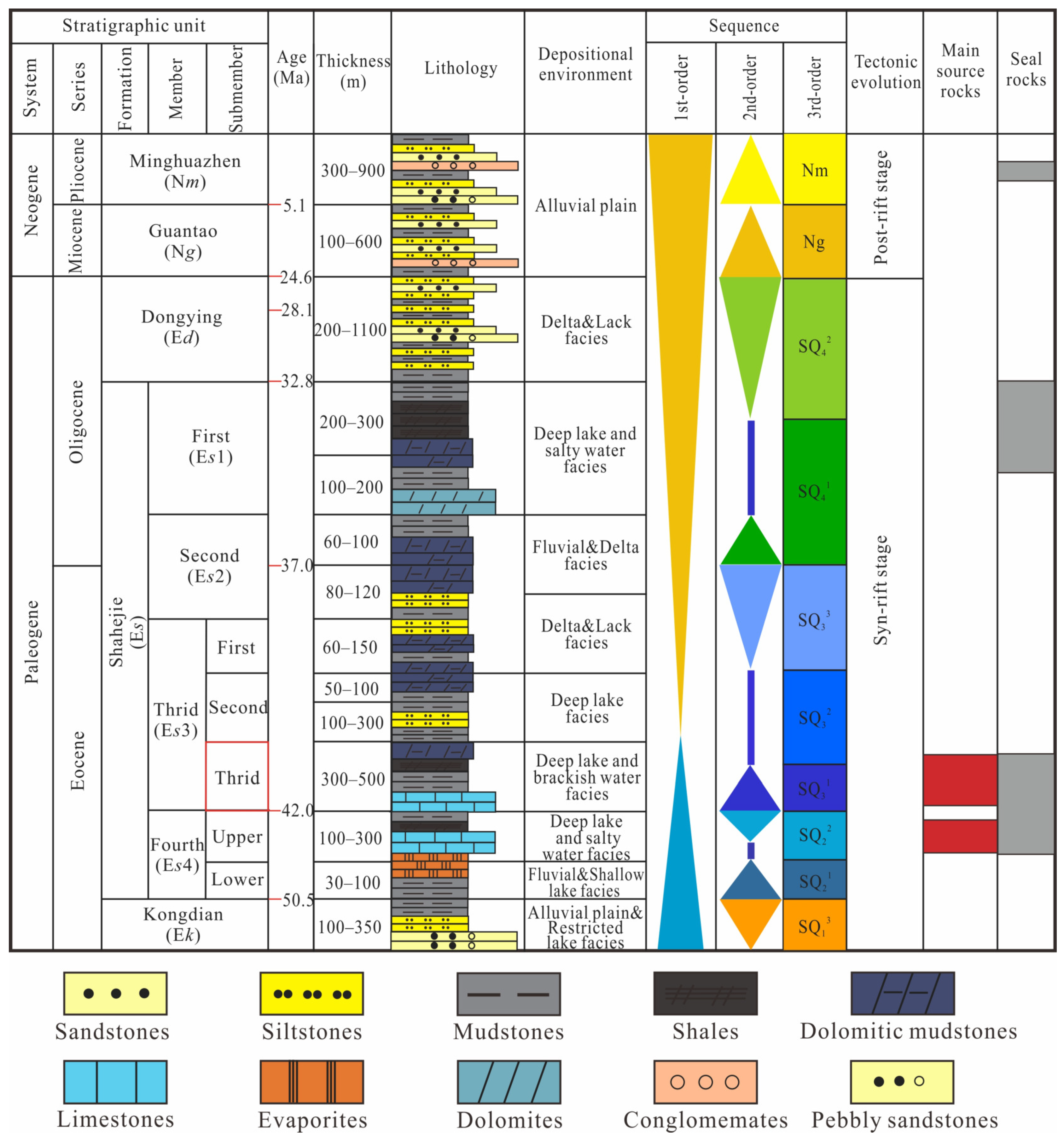
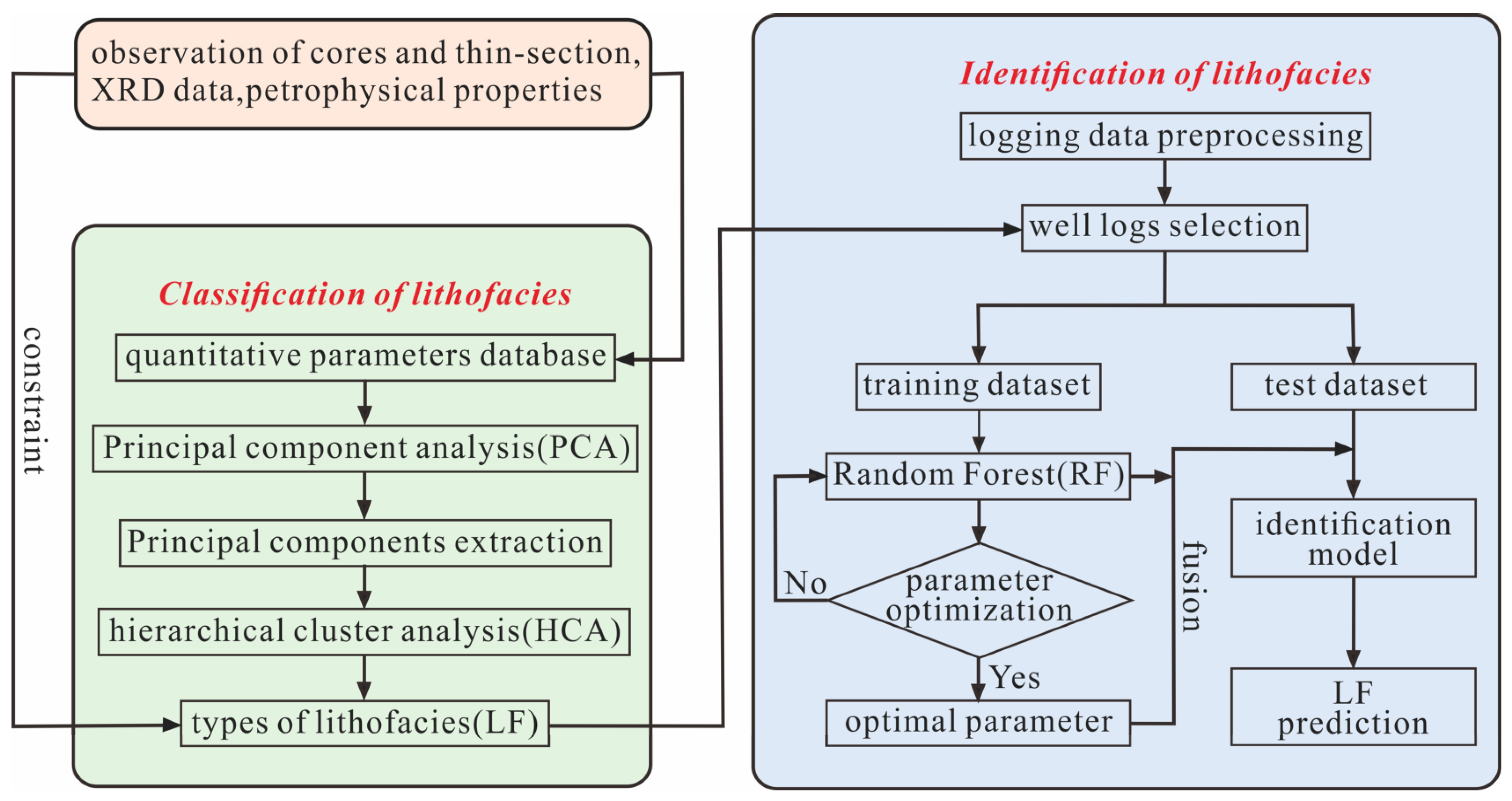
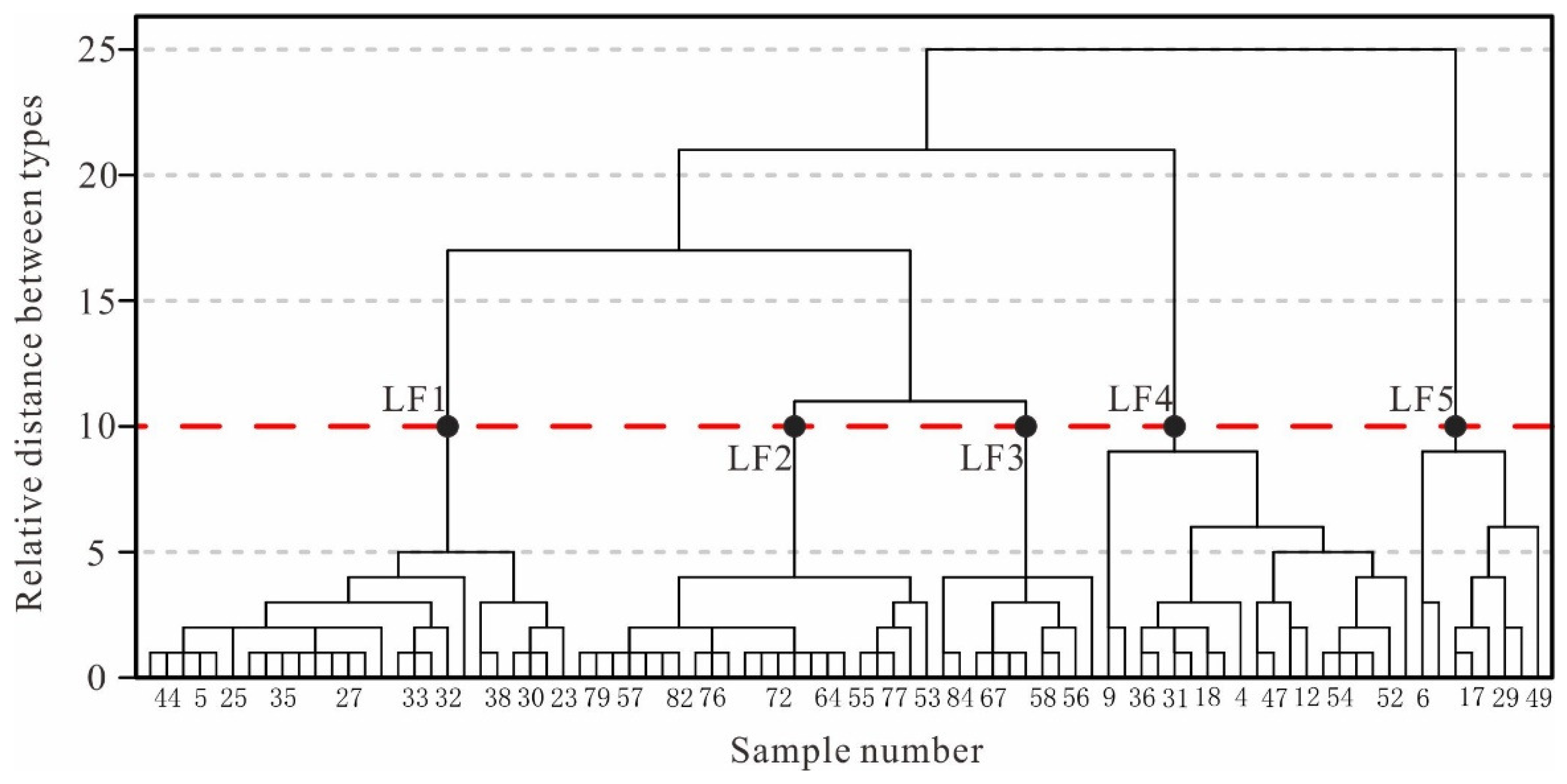


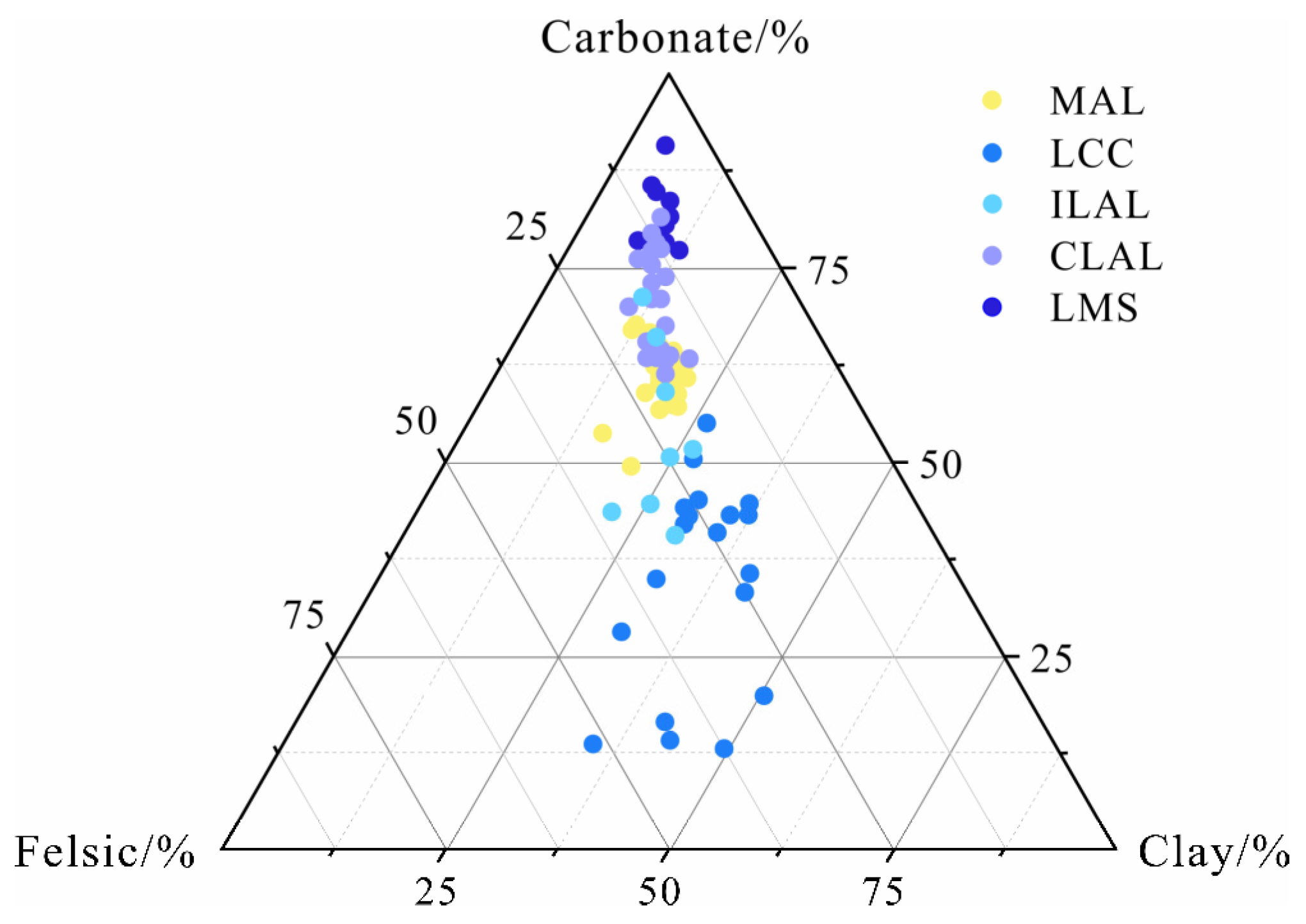
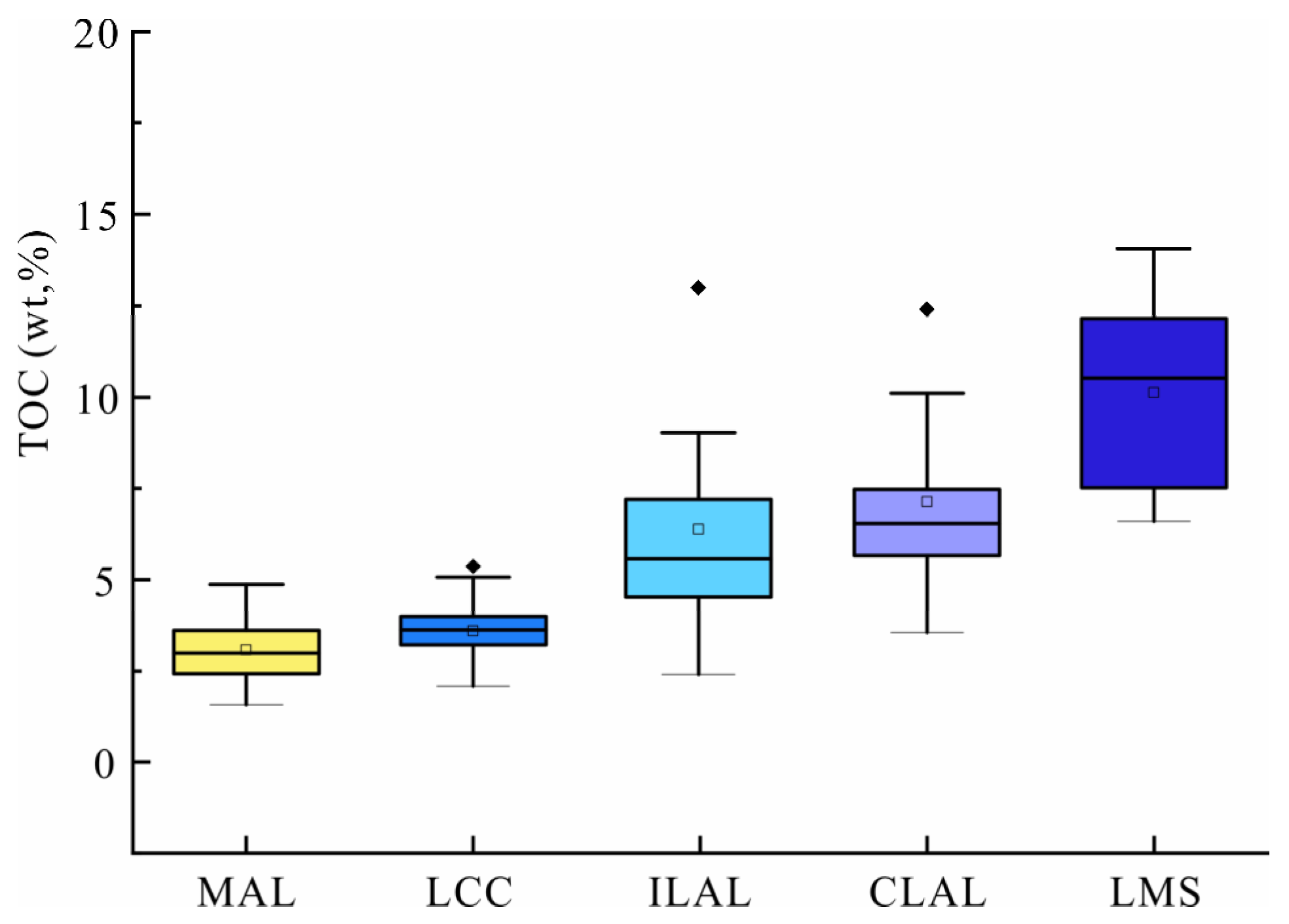
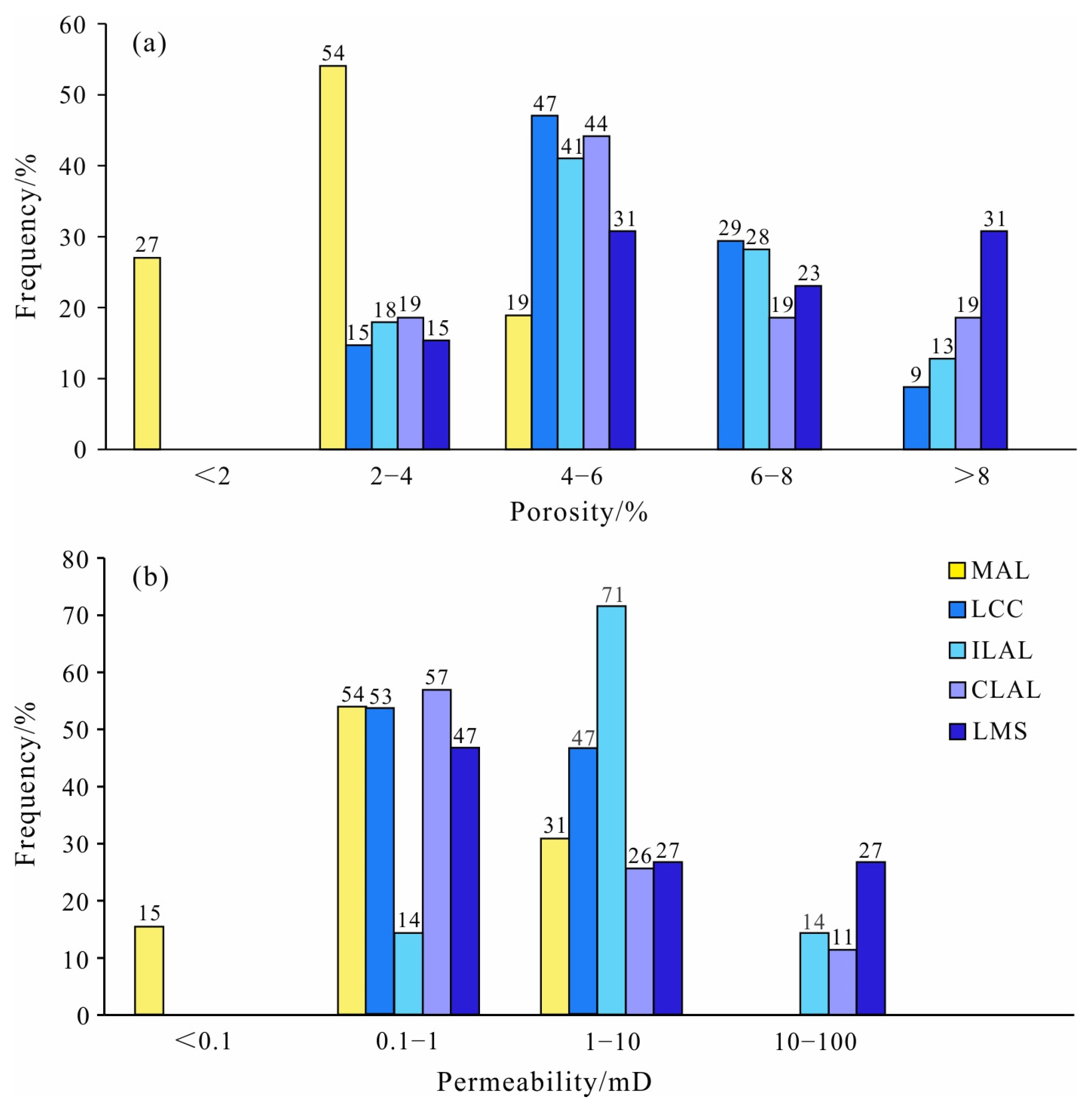
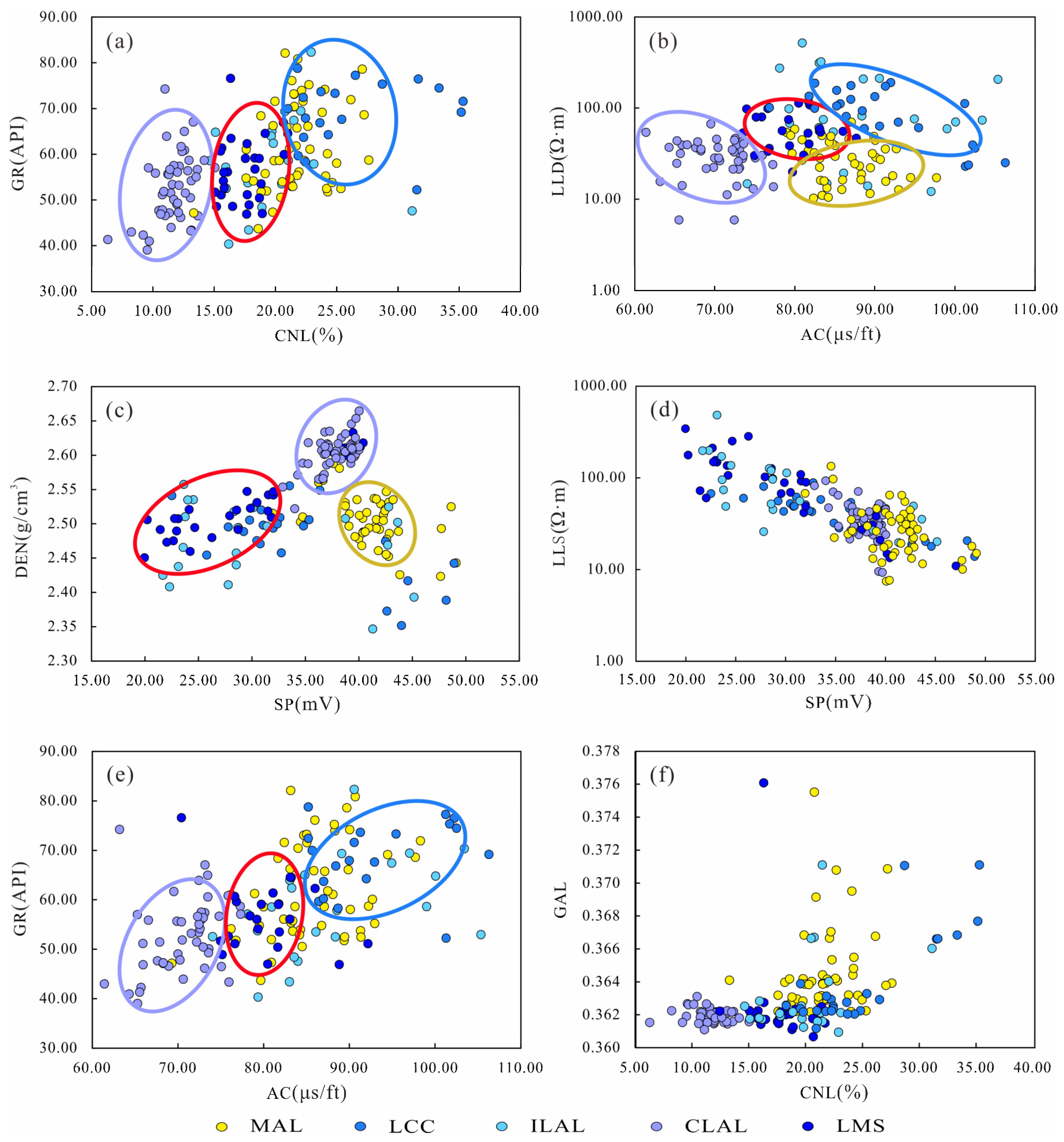
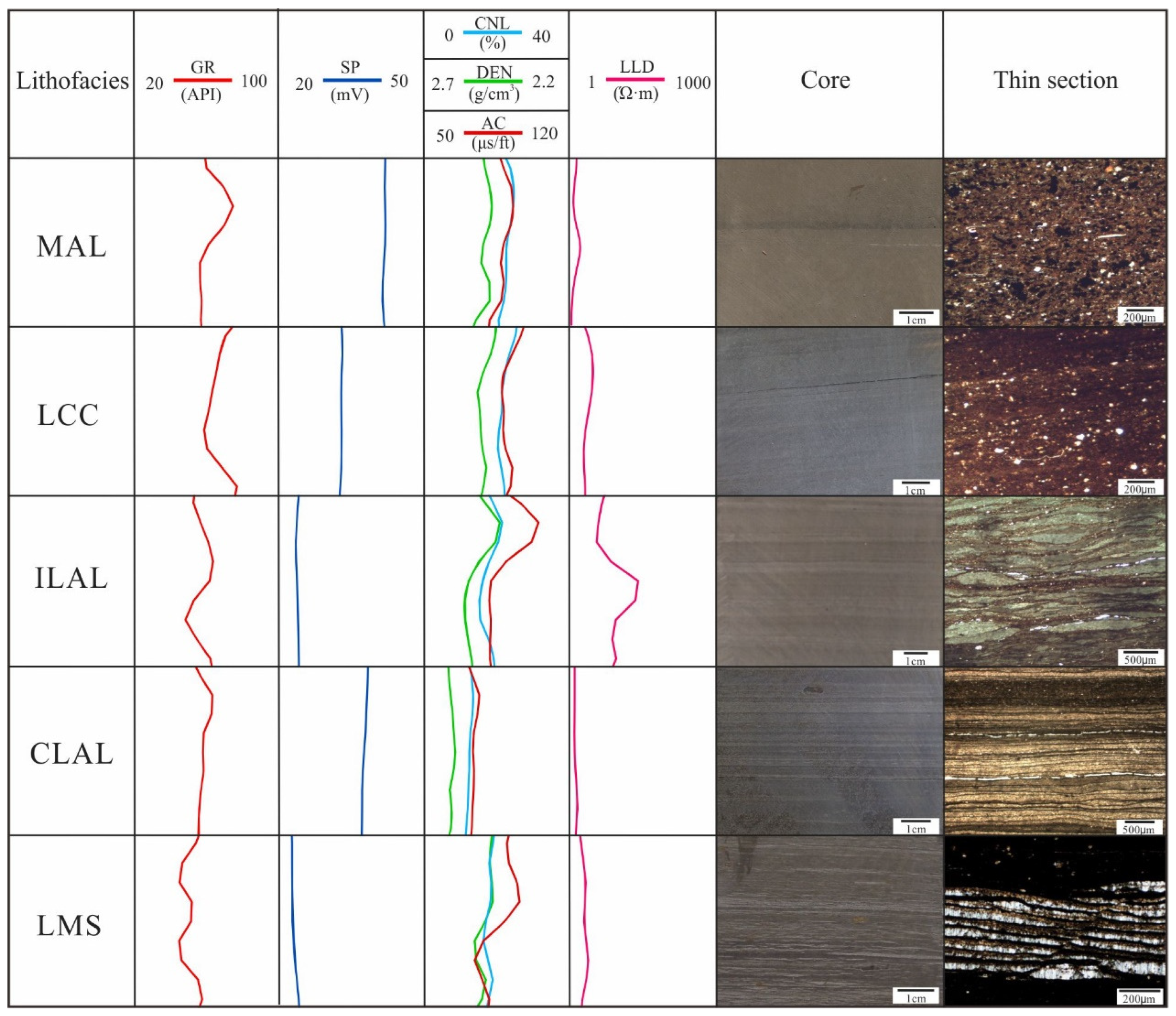
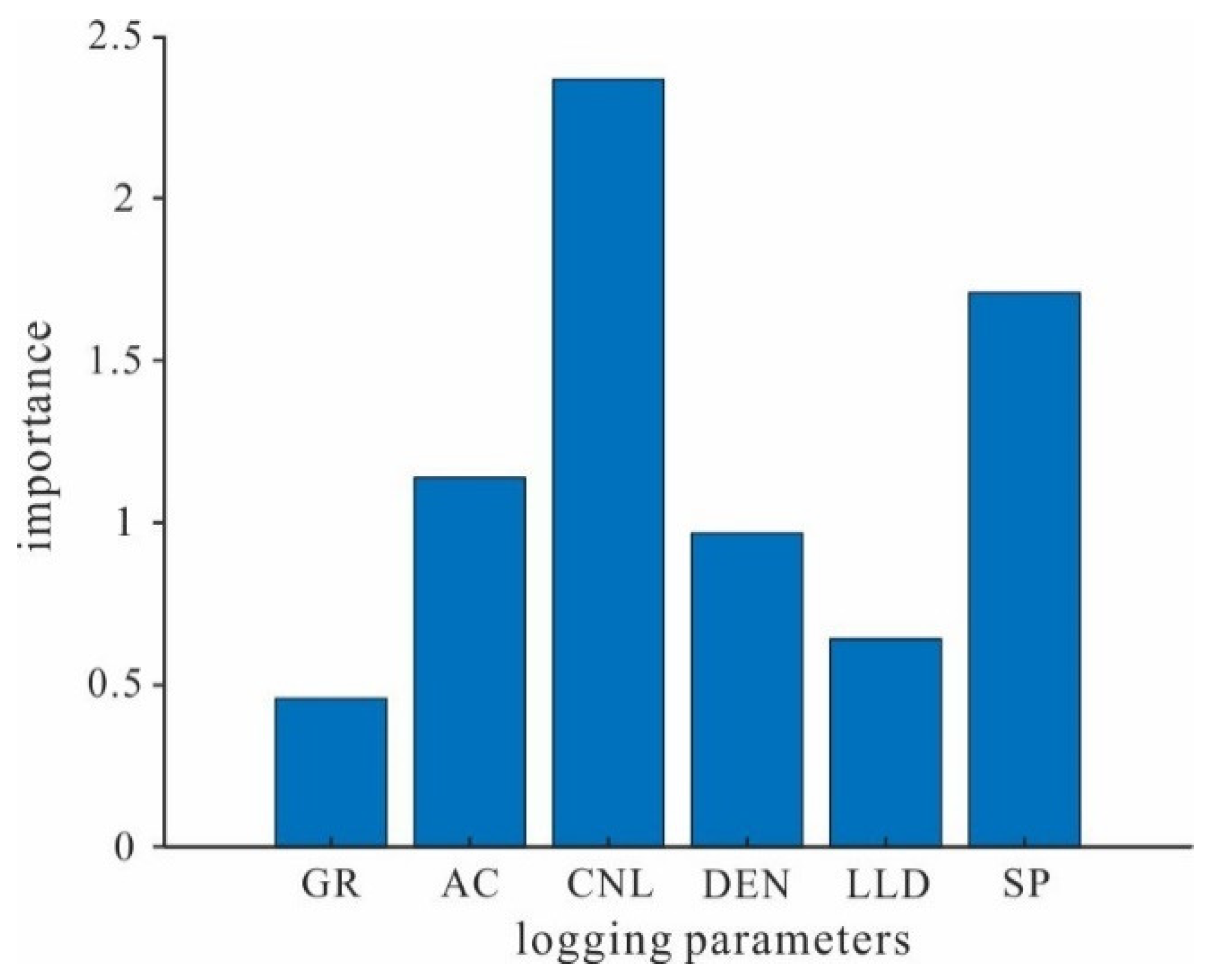
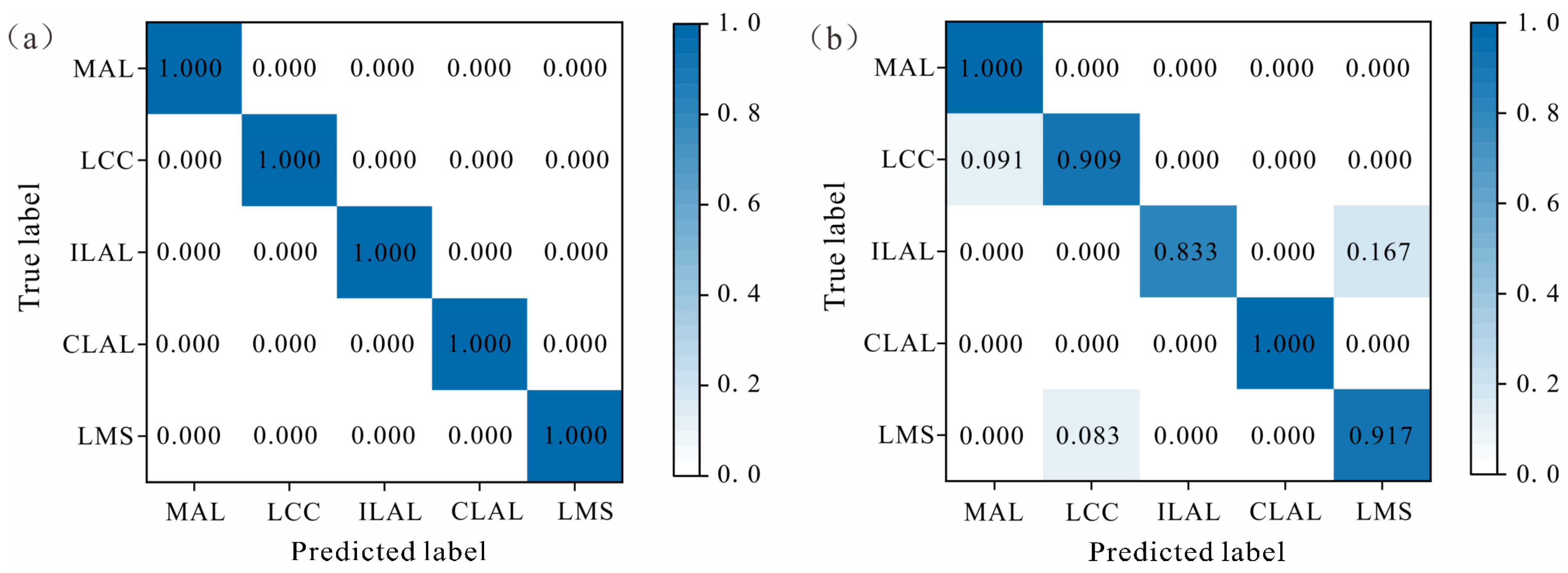
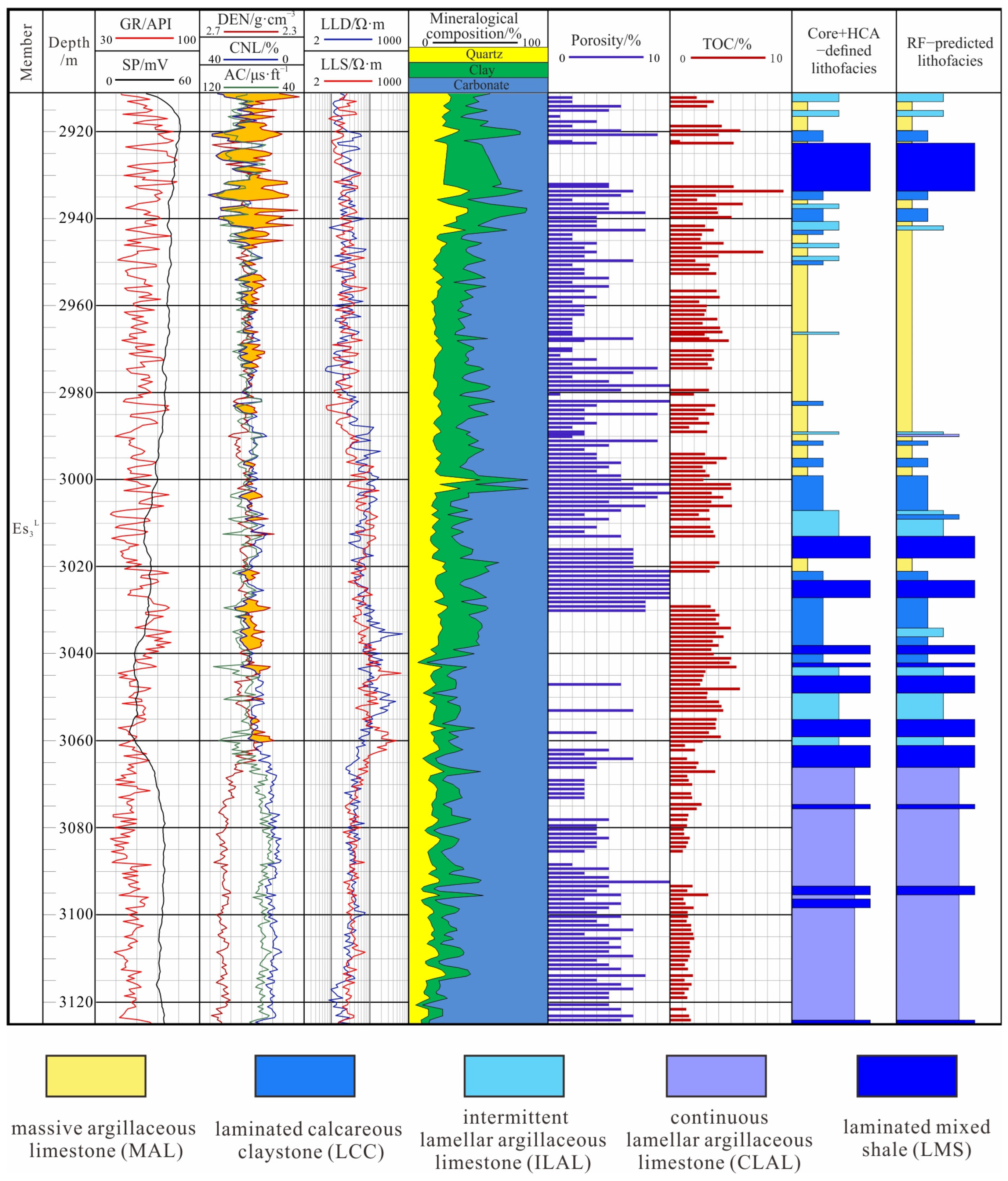
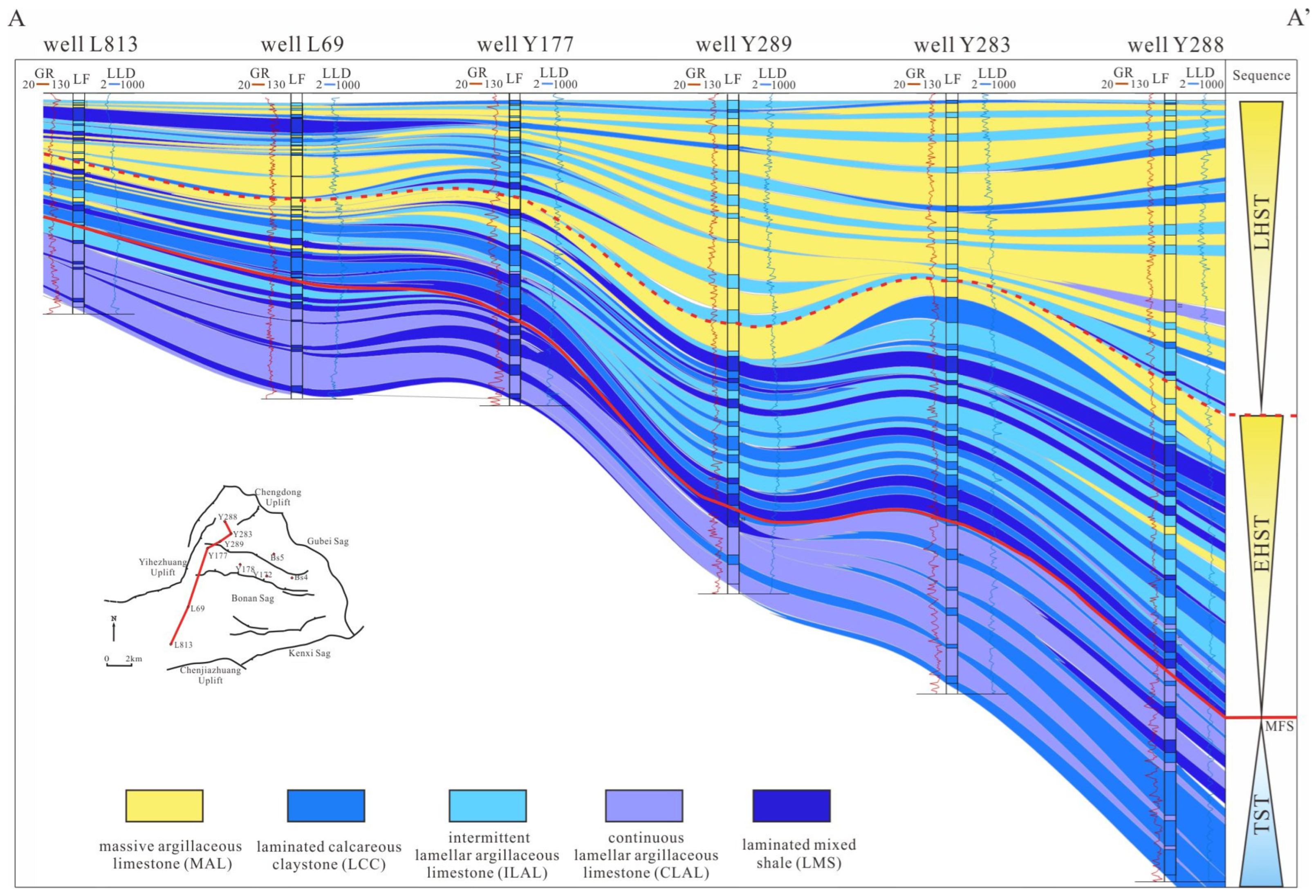
| Statistical Information | Bulk TOC (%) | Porosity (%) | Permeability (mD) | So | XRD Results | M-TOC (%) | ||
|---|---|---|---|---|---|---|---|---|
| Clay (%) | Carb (%) | Felsic (%) | ||||||
| N | 266 | 197 | 208 | 199 | 214 | 214 | 214 | 42 |
| mean | 2.9 | 4.8 | 4.5 | 62.7 | 19 | 57 | 20 | 7.3 |
| min | 0.5 | 1.3 | 0.1 | 27.8 | 4 | 12 | 5 | 0.6 |
| 25% | 1.7 | 3.2 | 0.6 | 52.5 | 12 | 49 | 16 | 3.6 |
| 50% | 2.7 | 4.6 | 1.9 | 60.7 | 18 | 58 | 19 | 5.2 |
| 75% | 3.7 | 6.1 | 10.1 | 73.3 | 24 | 66 | 22 | 10.2 |
| max | 9.3 | 10.4 | 75.3 | 97.2 | 48 | 89 | 45 | 22.4 |
| PCs | Component Score Matrix | Eigenvalues | Variance Contribution Rate/% | Cumulative Contribution Rate/% | |||||||||
|---|---|---|---|---|---|---|---|---|---|---|---|---|---|
| Clay | Carb | Felsic | Chlorite | Porosity | Permeability | So | Density | Structure | TOC | ||||
| PC1 | 0.194 | −0.208 | 0.195 | 0.113 | 0.089 | 0.097 | 0.007 | −0.196 | −0.001 | 0.183 | 4.524 | 45.240 | 45.240 |
| PC2 | −0.027 | 0.035 | 0.023 | 0.335 | −0.390 | 0.066 | 0.412 | 0.069 | −0.055 | 0.097 | 2.161 | 21.610 | 66.850 |
| PC3 | −0.155 | 0.072 | −0.004 | −0.100 | −0.075 | 0.518 | −0.023 | −0.020 | 0.691 | 0.055 | 1.259 | 12.590 | 79.440 |
| PC4 | 0.291 | −0.373 | 0.406 | −0.102 | −0.161 | −0.656 | 0.190 | 0.350 | 0.606 | −0.305 | 0.679 | 6.787 | 86.227 |
| PC5 | 0.222 | −0.338 | 0.318 | −0.013 | 0.015 | 0.759 | −0.014 | 0.554 | −0.406 | −0.767 | 0.525 | 5.254 | 91.482 |
| PC6 | 0.647 | 0.036 | −0.638 | −0.609 | 0.334 | 0.135 | 1.040 | −0.317 | 0.026 | −0.204 | 0.392 | 3.919 | 95.400 |
| PC7 | 0.045 | 0.214 | −0.431 | 1.386 | 0.926 | −0.130 | 0.038 | −0.134 | 0.439 | −0.724 | 0.266 | 2.657 | 98.057 |
| PC8 | −1.573 | 0.182 | 1.376 | −0.417 | 0.905 | −0.117 | 1.028 | −0.624 | −0.188 | −0.426 | 0.141 | 1.414 | 99.472 |
| PC9 | −0.189 | −0.023 | −0.061 | 0.083 | 2.150 | 0.165 | 0.834 | 3.123 | 0.010 | 2.369 | 0.048 | 0.482 | 99.953 |
| PC10 | 6.366 | 11.569 | 6.295 | 0.044 | 0.069 | 0.316 | −0.354 | 0.569 | 0.025 | 0.069 | 0.005 | 0.047 | 100.000 |
| Lithofacies Type | Sample Size | Proportion |
|---|---|---|
| massive argillaceous limestone lithofacies (MAL) | 44 | 22.45% |
| laminated calcareous claystone lithofacies (LCC) | 43 | 21.94% |
| intermittent lamellar argillaceous limestone lithofacies (ILAL) | 25 | 12.76% |
| continuous lamellar argillaceous limestone lithofacies (CLAL) | 51 | 26.02% |
| laminated mixed shale lithofacies (LMS) | 33 | 16.84% |
| total | 196 | 100% |
| Lithofacies | GR (API) | SP (mV) | CNL (%) | DEN (g/cm3) | AC (μs/ft) | LLD (Ω·m) |
|---|---|---|---|---|---|---|
| MAL | 44–62 51 | 32–40 36 | 18–27 23 | 2.49–2.56 2.52 | 69–92 85 | 10–82 32 |
| LCC | 70–92 86 | 29–32 30 | 18–25 22 | 2.48–2.54 2.50 | 76–93 86 | 105–133 119 |
| ILAL | 58–74 63 | 22–29 26 | 16–30 20 | 2.43–2.56 2.50 | 74–105 93 | 205–483 334 |
| CLAL | 40–57 48 | 33–40 38 | 7–15 12 | 2.56–2.66 2.61 | 62–83 71 | 11–96 43 |
| LMS | 37–56 47 | 20–30 26 | 19–24 22 | 2.35–2.48 2.45 | 75–102 91 | 82–107 106 |
| Parameters | Search Range | Step Size | Optimal Value |
|---|---|---|---|
| the number of decision trees | 10~200 | 10 | 50 |
| the maximum tree depth | 1~15 | 1 | 10 |
| the number of features when the tree splits | 1~6 | 1 | 3 |
| Lithofacies | Training Datasets | Test Datasets | ||||||
|---|---|---|---|---|---|---|---|---|
| Accuracy | Precision | Recall | F1-Score | Accuracy | Precision | Recall | F1-Score | |
| MAL | 100.0% | 100.0% | 100.0% | 100.0% | 98.3% | 100.0% | 87.5% | 93.3% |
| LCC | 100.0% | 100.0% | 100.0% | 100.0% | 96.6% | 90.9% | 90.9% | 90.9% |
| ILAL | 100.0% | 100.0% | 100.0% | 100.0% | 98.3% | 83.3% | 100.0% | 90.9% |
| CLAL | 100.0% | 100.0% | 100.0% | 100.0% | 100.0% | 100.0% | 100.0% | 100.0% |
| LMS | 100.0% | 100.0% | 100.0% | 100.0% | 96.6% | 91.7% | 91.7% | 91.7% |
| Average | 100.0% | 100.0% | 100.0% | 100.0% | 97.9% | 93.2% | 94.0% | 93.4% |
Disclaimer/Publisher’s Note: The statements, opinions and data contained in all publications are solely those of the individual author(s) and contributor(s) and not of MDPI and/or the editor(s). MDPI and/or the editor(s) disclaim responsibility for any injury to people or property resulting from any ideas, methods, instructions or products referred to in the content. |
© 2024 by the authors. Licensee MDPI, Basel, Switzerland. This article is an open access article distributed under the terms and conditions of the Creative Commons Attribution (CC BY) license (https://creativecommons.org/licenses/by/4.0/).
Share and Cite
Chang, Q.; Ruan, Z.; Yu, B.; Bai, C.; Fu, Y.; Hou, G. Data-Driven Classification and Logging Prediction of Mudrock Lithofacies Using Machine Learning: Shale Oil Reservoirs in the Eocene Shahejie Formation, Bonan Sag, Bohai Bay Basin, Eastern China. Minerals 2024, 14, 370. https://doi.org/10.3390/min14040370
Chang Q, Ruan Z, Yu B, Bai C, Fu Y, Hou G. Data-Driven Classification and Logging Prediction of Mudrock Lithofacies Using Machine Learning: Shale Oil Reservoirs in the Eocene Shahejie Formation, Bonan Sag, Bohai Bay Basin, Eastern China. Minerals. 2024; 14(4):370. https://doi.org/10.3390/min14040370
Chicago/Turabian StyleChang, Qiuhong, Zhuang Ruan, Bingsong Yu, Chenyang Bai, Yanli Fu, and Gaofeng Hou. 2024. "Data-Driven Classification and Logging Prediction of Mudrock Lithofacies Using Machine Learning: Shale Oil Reservoirs in the Eocene Shahejie Formation, Bonan Sag, Bohai Bay Basin, Eastern China" Minerals 14, no. 4: 370. https://doi.org/10.3390/min14040370
APA StyleChang, Q., Ruan, Z., Yu, B., Bai, C., Fu, Y., & Hou, G. (2024). Data-Driven Classification and Logging Prediction of Mudrock Lithofacies Using Machine Learning: Shale Oil Reservoirs in the Eocene Shahejie Formation, Bonan Sag, Bohai Bay Basin, Eastern China. Minerals, 14(4), 370. https://doi.org/10.3390/min14040370







